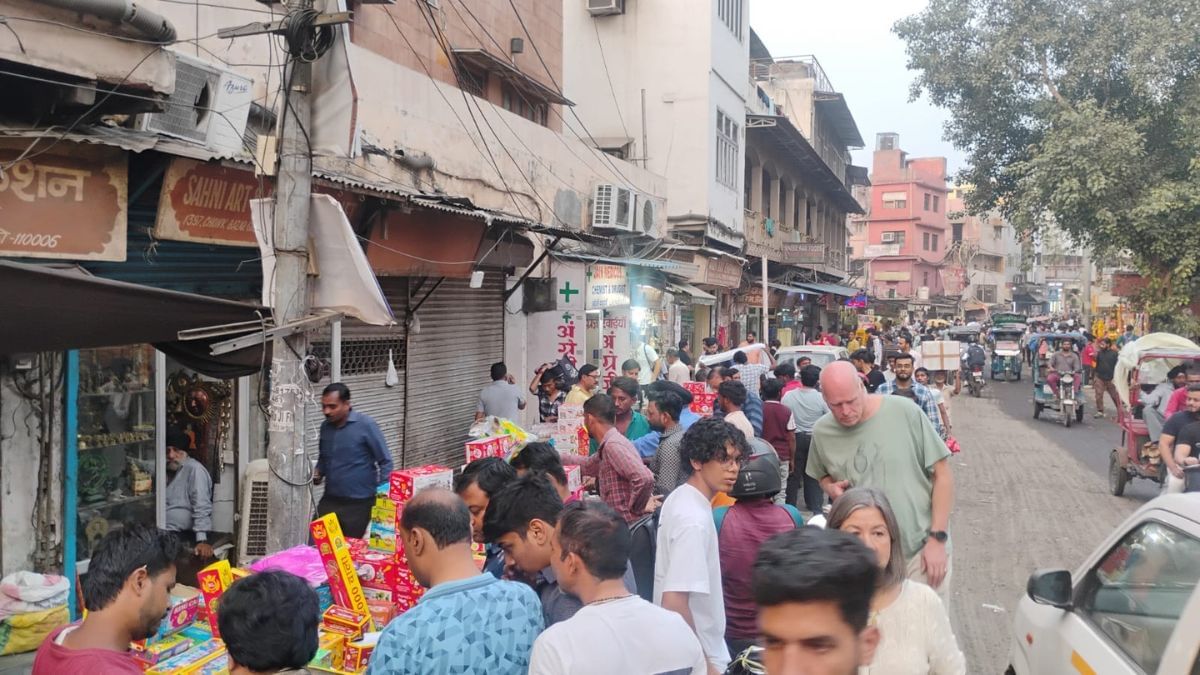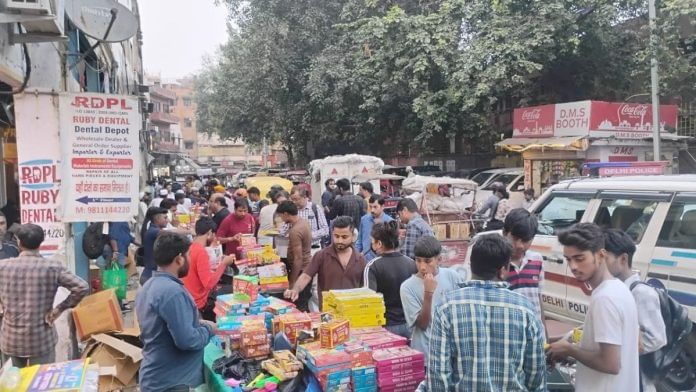New Delhi: The firecracker market near Jama Masjid had a desolate look on 11 October, a Friday. On a visit to the area, ThePrint found most shops had their shutters down, and the few that remained open were only selling lighting effects and sound equipment. A couple of shops displayed a single sample of green crackers but said they wouldn’t accept orders unless the Supreme Court eased the ongoing ban on firecracker sales.
ThePrint also spotted at least a dozen hand carts lining the street outside the closed shops, openly selling crackers. Occasionally, a ‘2000-wallah’—a long string of 2,000 interconnected firecrackers that explode in rapid succession—was seen among the merchandise. Most cracker packages were labeled with “Eco-friendly” printed in green. One unusual store was selling toy ‘pop’ guns for children. “Sales are slow,” said a street vendor as a rare customer browsed his wares. “We are only selling ‘pop pops’ and a few children’s items,” he added.
On 15 October, the Supreme Court permitted the sale of National Environmental Engineering Research Institute (NEERI)‑approved ‘green’ crackers in the Delhi‑NCR for a limited period, 18‑20 October, at designated licensed locations.
The bursting of these crackers is allowed only on the day before Diwali and on Diwali day, during the hours 6 am–7 am and 8 pm–10 pm. Only certified green crackers with QR codes are for sale; conventional crackers remain banned; online sales remain prohibited; and no supply from outside the NCR is permitted.
The previously sanctioned method of identifying green crackers via QR code from NEERI now stands effectively abandoned due to implementation issues—counterfeit manufacturers were able to acquire a QR code or could copy the code. Moreover, the verification app, which had its problems, was eventually pulled from app stores.
Now, the Supreme Court has shifted the responsibility to manufacturers, who must affix QR codes to their packaging so customers can verify products. However, this relaxation of the cracker ban is only on a test-case basis. The Court’s order outlines strict monitoring of firecracker stocks and air quality levels during this period.
Also Read: Supreme Court’s nod to green cracker is headache for Delhi agencies. Implementation is key
Shift in firecracker market near Jama Masjid
Back in the firecracker market near Jama Masjid, shopkeepers sounded cautiously hopeful even before the Supreme Court verdict. “This time, the government is on our side, and we may be able to do some business,” quipped store owner Ram Dass Friday, as he turned away curious customers checking for crackers. Ram Dass’s family has been in the cracker business for more than six decades. He showed a dozen missed calls from people who, he said, had asked about firecrackers this year, but he had to ignore them.
That was on 11 October. Four days later, the Supreme Court passed its order. Now that the sale of green crackers is allowed for three days, traders are taking orders, hoping to fulfil them, with the supply they can arrange within days.
Cut to 18 October. The firecracker market near Jama Masjid was bustling with activity. ThePrint saw crowds of customers demanding the crackers they wanted. Two store owners sat idle. They said they had already sold their stock for the day. There were fewer kinds of crackers to sell this year, said one of them.

Shoppers, however, did not look pleased. Many complained to ThePrint that there is no “variety”.
Krishan Kumar, a shopper, said, “We got just a few crackers like sparklers. Last time, every kind of cracker was available for buying.” Asked how that was possible last year despite a cracker ban, he said, “There is a front-end way and a back-end way. I guess that there is more supervision this time.”
Shops ran out of sky shots and anaars. “We are getting some stock in one hour,” shouted one of the shopkeepers, as his customers complained.
None of the cracker manufacturers in Delhi-NCR has units up and running, so far. Many have licenses to manufacture green crackers from the Petroleum and Explosives Safety Organisation (PESO). However, their applications for manufacturing crackers will take time to be approved by the local authorities. This Diwali, so far, they have not sold any products, but are willing to start their units as soon as permitted. “This is the only work we know,” explained Dinesh Srivastav of Shri Ganesh Fireworks, Ghaziabad.
Manufacturers say they are ready to comply with NEERI guidelines—the ingredient all of them are aware they have to remove from ingredients is barium nitrate.
“NEERI had listed four to five chemicals to be removed or reduced from our compositions. We are ready to follow them,” said Sushil Tyagi of Aarya Enterprises, Ghaziabad.
Also Read: This Diwali is the first pollution test for Delhi CM Rekha Gupta
Green crackers & how they work
Green crackers are designed using CSIR-NEERI formulations that aim to reduce pollution levels. “According to the requirements of the government, we had made firecrackers that achieved a 30 percent reduction of particulate matter from the 2019 baseline.” Dr R.J. Krupadam, Chief Scientist, Climate Change and Green Material at NEERI, told ThePrint. “We have now achieved a 45-50 percent reduction from that baseline.”

These crackers exclude toxic substances such as lithium, lead, and arsenic. For sound-emitting crackers, NEERI’s standards cap the noise level at 110 dBA—a decibel scale adjusted to human hearing sensitivity.
All crackers are tested in special facilities, and environmental factors such as wind speed, temperature, humidity, and fog can impact emissions and noise outcomes.
Every firecracker consists of a fuel and an oxidant. These components react chemically, releasing energy in the form of fire or an explosion. However, when this mixture is unbalanced—either due to excess fuel or oxidant—the reaction becomes inefficient. This leads to leftover materials and the release of harmful pollutants.
This process is similar to how a poorly tuned engine emits excess smoke, or how a traditional chulha (wood stove) emits more smoke when it doesn’t get enough air.
One key improvement in NEERI’s green cracker formulations is a more optimal fuel-oxidant ratio. These crackers also burn at higher temperatures—from 600–700°C in traditional crackers to around 1,000°C in green versions. This improves combustion efficiency and reduces pollution.
Additionally, special additives in green crackers encourage the formation of heavier byproducts. These settle into the soil rather than floating in the air, further lowering particulate pollution.
Buying the right crackers
The recommended method to buy green crackers previously was to look for a green NEERI logo and a QR code that verified the identity of the firecracker and its manufacturer.
However, that system faced many problems during implementation. Simply put, if any counterfeit manufacturer copies the packaging of a genuine green cracker manufacturer, the product would pass the verification procedure.
Last year, the onus was on NEERI/PESO to create unique ‘secure’ QR codes but now the sanctioned manufacturers have to create them, said Dr Krupadam. The list of sanctioned manufacturers is available on the NEERI website.
As for the CSIR-NEERI logo on packaging, Dr Krupadam added, “We have no objection to registered manufacturers displaying it. But we haven’t given formal permission to anyone.”
Many NEERI-registered manufacturers sell their products under a different brand name.
It is now up to manufacturers to implement mechanisms, such as QR codes, to help customers recognise genuine products. Supreme Court has instructed manufacturers to register QR codes with NEERI and PESO so products in the market can be monitored. But due to short timelines, it’s unclear whether this system will be fully enforceable this Diwali.
The top court’s order said that the patrol teams shall conduct regular reconnaissance in the designated cracker markets to ensure only permitted products, that, too, having the QR codes issued, are sold. However, it’s unclear whether this system will be fully enforceable this Diwali at such short notice.
Enforcement still a challenge
There are only two fireworks testing facilities, called RACE, in India—one in Maharashtra’s Nagpur and another in Tamil Nadu’s Sivakasi. Here, the crackers are tested for the purity of their raw materials, air emissions, and noise. Reports are then sent to the authorities on their features.
Sanctioned in November 2023, a new firecracker testing facility is in the process of being set up in Haldia, West Bengal. Delhi-NCR has no such facilities for testing, certification, or systems for law enforcement to inspect firecracker stocks on the ground and visually confirm that they are green. Monitoring the products in the market is the only way to enforce use of green crackers. The Supreme Court order specified the roles of PESO, the central and state pollution control boards, and the district and police authorities.
PESO, in coordination with state governments and the police, will conduct intensive, random, and surprise inspections, collecting samples directly from firecracker manufacturing and storage sites and sellers to ensure they conform to NEERI formulations.
Aditya GV is an alum of ThePrint School of Journalism, currently interning with ThePrint.
(Edited by Madhurita Goswami)
Also Read: SC allows green crackers in NCR: How it straddled line between ‘festive spirit’ & health concerns






